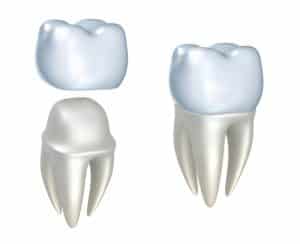Porcelain crowns and veneers are types of tooth restoration frequently performed by dentists to help restore the teeth and mouth back to function.

In cosmetic dentistry, stained, discoloured and mildly crooked teeth can be corrected using porcelain veneers or composite white fillings (or composite veneers), especially if patients do not want to have orthodontic treatment with braces. These treatments can also be used to increase the length and size of small teeth.
Porcelain crowns
Crowns, or “caps” as they are commonly known, are porcelain restorations that fully encapsulate the teeth. A dentist will often recommend a crown when a tooth is heavily restored and has a higher likelihood of fracturing or after having a root canal procedure to protect the tooth from splitting or being re-infected. As crowns encompass the whole tooth they can be quite destructive as they require a lot of tooth to be drilled away.
Porcelain veneers
Porcelain veneers are just like false fingernails. They are thin layers of porcelain that are strongly bonded to the underlying tooth surface.
In most cases treatment with veneers is carried out by a dentist to help improve the appearance of a patient’s smile. Veneers have the ability to improve tooth shape, shade and (in many instances) inclination in the most attractive and natural ways possible. Although not always recommended, veneers have the ability to help mask tooth crowding, which can be a quick fix to unsightly overlapping without lengthy orthodontic treatment. Porcelain veneers often require some element of tooth preparation to allow space for the porcelain to bond and achieve the desired aesthetic result.
An accurate impression of the prepared teeth is taken and sent to a laboratory to hand-fabricate the custom-made veneers. Technology is always improving and we now have veneer materials that are 3 to 4 times stronger than the traditional porcelain veneer material. Temporary, plastic veneers may be placed during the fabrication process. The final veneers are then tried in the mouth and checked for accurate fitting as well as shape and colour. If everyone is happy, the veneers are cemented in place with a strong bonding resin cement and your beautiful smile is complete!
Beware of cheap imitations as poorly fitting veneers can cause gum problems, including bleeding, and promote dental decay. They can sometimes also look unsightly and unnatural if not designed and fabricated to the highest standard. A lot of the success of veneers depends on the ability of the prosthodontist to preserve tooth structure and at the same time mimic nature.
At the end of treatment, a splint or night guard is often suggested after any veneer treatment to protect the new restorations from tooth grinding at night time.
Composite veneers
Composite veneers are similar to porcelain veneers in that a thin layer of material is bonded to the facing of a tooth to help with shape, shade and inclination. However, as the name indicates, the material used in this type of tooth restoration is a composite, which is inherently weaker and less attractive. Nevertheless many experienced clinicians can still achieve excellent natural results with this material. The big advantage of composite veneers over the porcelain alternative is that tooth underneath rarely needs to be prepared or drilled away; rather, the material is directly bonded to untouched tooth. Because of the minimally invasive nature of composite veneers they can be a great interim option (3 to 5 years) for younger patients.
Being more porous than porcelain veneers, composite veneers can stain and chip over time and may require regular polishing to address this spoiling. The larger the restoration and the greater the number of restorations, the more challenging it is for your prosthodontist to control the size, shape and colour of your veneers using direct composite fillings. If many teeth, or large portions of teeth, are involved porcelain veneers may be the preferred option.
Differences

In the hands of the right clinician both crowns and veneers have excellent longevity.
In summary, the main differences between the two types of restoration are as follows.
- Crowns are quite destructive to underlying tooth, and tooth preparation often means loss of a lot of enamel. Veneers are minimally invasive to the underlying tooth, with many requiring little to no tooth preparation.
- Crowns help protect root canal–treated teeth from re-infection and risk of splitting and help prevent teeth that are heavily restored from fracturing. Veneers address aesthetic issues rather than helping protect fracture-prone teeth.

